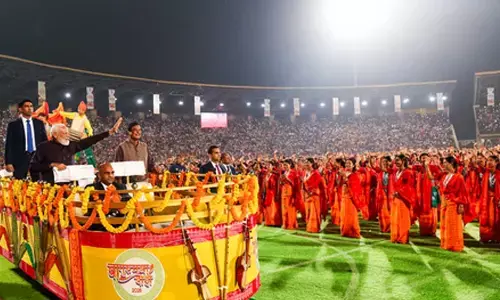Moula Ali Kaman cries for help
_7442.jpg)
Cluttered with posters and advertisements of local events or services, the Moula Ali Kaman stands in a deteriorated condition.
Moula Ali: Cluttered with posters and advertisements of local events or services, the Moula Ali Kaman stands in a deteriorated condition. Despite being lit up for the Milad festivities, the 250-year-old arch looks shabbier than ever with paint peeling off its pillars. It is unfortunate that the Kaman which carries an aura of Nizam era had been neglected by not just the government but also the residents living in its vicinity. Motorists and pedestrians spit paan or gutka through the barricades of the arch, paying no attention to the historic significance it. With no one to maintain, the historic structure had been reduced to a mere insignificant gateway being utilised as any other roadside wall. Even six years after being restored by the State archaeology, the Kaman still shows no sign of relief.
“The Kaman is really not being given the respect it deserves. Not just forts and Mausoleums, even smaller and ubiquitous structures like these deserve to be preserved for the future generation to know their roots,” said Ahmed, a resident. Another citizen of Moula Ali opines that the absence of stringent laws and regulations in conserving cultural symbols is what encouraging people to cause damage to them. The structure had witnessed many damages to its architecture in the earlier times, but now its identity is at stake with only a handful of people knowing its glorious past. The arch was constructed during the Asaf Jahi period. It is believed that pilgrims and devotees would halt at the Kaman and remember the supreme power before visiting the famous Moula Ali Dargah on top of a hill. According to historical evidences, the nobles and soldiers of the Nizam rulers would take out long processions from the arch on the elephant back to visit the holy shrine.
Thus, a concerted effort to preserve our heritage structure is essential to remind us of the legacies that shaped us into who we are today.














